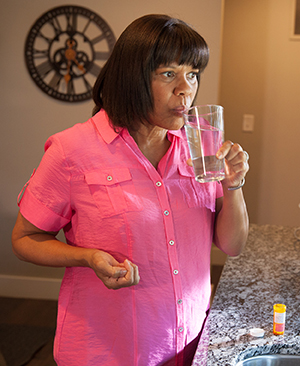Common Hormone Therapy Programs for Women

Which hormones you take and when you take them is called your hormone therapy (HT) program, or regimen. Your program is tailored for you, based on certain factors. These factors include whether you have a uterus and your risk of cancer. Whether or not you have reached menopause is also a factor. Note that there are both risks and benefits to HT. Discuss these with your healthcare provider before starting 1 of these HT programs:
Cyclic estrogen and progestin
You take estrogen all month and progestin about half the month. This method is based on a normal menstrual cycle. You may have bleeding.
Combined continuous
You take a lower dose of progestin. Both estrogen and progestin are taken each day of the month. You’re likely to have the symptoms of a menstrual cycle. And you still reduce your risk of uterine cancer. But symptoms may be present during the entire cycle.
Combined continuous with a break
You take 5 to 7 days off before estrogen and progestin each month. You may have less irregular bleeding with this program.
Unopposed estrogen
Estrogen is prescribed by itself. This is most likely if you have had a hysterectomy. It's unusual to use this choice if you still have a uterus, and you would need yearly tests to check for uterine cancer.
Combined estrogen and androgens
Estrogen is combined with hormones called androgens. This choice may be prescribed if your symptoms are not controlled by estrogen alone and you have had a hysterectomy. If you have a uterus, you may need estrogen, androgen, and progesterone combined.
Birth control pills may be prescribed if you are close to menopause and start to have symptoms. These pills control the menstrual cycle. You will still have monthly bleeding.